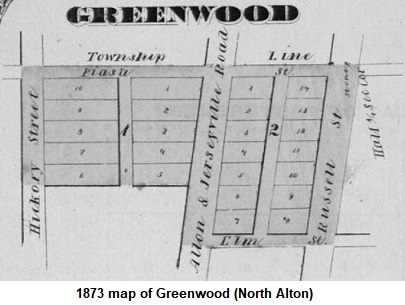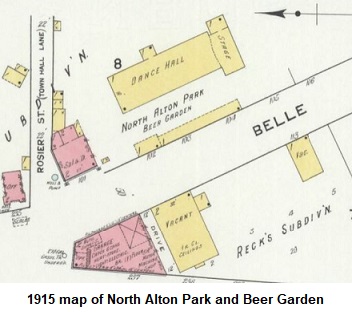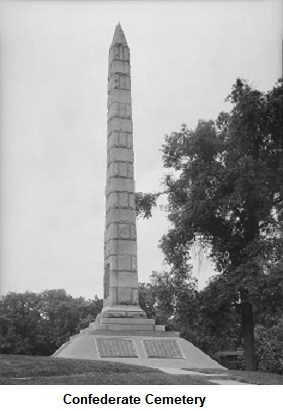Early North Alton History
North Alton Newspaper Articles
Partly in Godfrey Township and partly in Alton Township, the village of North Alton was comprised of three different settlements: Altonia, Buck Inn, and Greenwood. Altonia encompassed the entire area of what is now known as North Alton, while Buck Inn (named after the Buck Inn and tavern, located at the northwest corner of State & Delmar) encompassed the area north of Delmar. Greenwood encompassed a small area south of Delmar. Before settlers arrived, the area was mostly woods and prairie, with a good vein of coal running through.
Altonia
On June 01, 1839, a sale of lots in the new town of “Altonia” was
announced by agents Willard & Carpenter, W. S. Lincoln, and C. L.
Frost. The sale was

Why the town of Altonia failed to develop is a mystery. Very likely
the sale of lots was a failure. The 1837 depression was nearing its
peak, and that may have played a factor. Had the sale been a
success, history would show there would have been three Altons –
Lower Alton, Upper Alton, and Altonia.
Buck Inn
The Buck Inn and tavern was constructed in 1837 by James Strong, a
native of Cumberland, England. The inn was a large frame building,
over the doorway of which the antlers of a buck were suspended
(hence the name Buck Inn). This building stood on the south line of
Godfrey Township in a heavily wooded area, at the northwest corner
of Delmar Avenue and State Street. Buck Inn was at a crossroad of
growing importance, and soon began to thrive.
The original Buck Inn was destroyed by fire in 1855, and soon a
brick structure was erected. James Strong died in 1869, and his son,
Jacob Strong, carried on a store at this point.
In 1868 a post office was established in Buck Inn in the home of
Captain P. J. Melling. William Hall, two years later was appointed
postmaster, and the office was moved to Greenwood, although the post
office was still called Buck Inn up to the time of the incorporation
of North Alton.
Adolphus Denz built a steam mill at Buck Inn in 1860. The machinery
from the mill was transferred in 1882 to a new mill erected just
north of North Alton. There was also a blacksmith shop, wagon shop,
and marble cutting shop.
Greenwood
The town of Greenwood, in Alton Township, just south of Buck Inn,
was surveyed into lots by James Clayton Tibbett. Why he named the
town Greenwood is unknown. The town plat was recorded in February
1853. His plat took in an area extending about a block south of what
is now Delmar Avenue, and extended east to Tibbitt Street, and west
to Kirsch. The name of Greenwood did not catch on with the
community, and most referred to it
The Greenwood Hotel was located on State Street near School Lane
(Mather Street). It was later used by the Kolb family as their home.
The hotel was destroyed by fire in 1901. The Kolb family removed the
ruins, cleaned out the cellar, and fixed the remaining foundation
walls. A new brick building consisting of two four-room flats was
erected in its place.
An athletic club called the Greenwood Athletics existed in 1908.
They had their own clubroom, which was used for entertaining.
Members of the club included Ollie Meyer, Paul Weissenfluh, C. Cain,
Ed Zaugg, Arthur Hibbard. They enjoyed boxing, sparring, and
wrestling.
Founding of North Alton
In December 1875, the original plat of Greenwood, Buck Inn, and Coal
Branch were incorporated and given the name of North Alton. Coal
Branch was in Godfrey Township, just to the north and east of Buck
Inn. In 1908 the village was annexed to the city of Alton. The North
Alton city hall was located near where Gent Funeral Home’s parking
lot is. There was a large fountain on the tip of the triangle where
State and Belle Streets meet. The fountain was often used to water
horses.
The North Alton firehouse, located at 2411 State Street, was
constructed in 1911. It was last used as a firehouse in 1990. The
land is now part of the Gent Funeral Home parking lot.
Early North
Alton Businesses
By 1882 there were two general stores in North Alton, kept by H. A.
Betz & Co., and Charles Henderson. Anthony Buri and Kohler & Walter
were proprietors of grocery stores. John Redmond and William P. Kolb
were dealers in harness and saddles. George F. Barth was the
druggist, and there were two millinery stores, one butcher, and one
shoemaker shop. There were also two blacksmith shops, one livery
stable, and seven saloons.
A custom mill stood at State and Rozier Streets, and was still
standing in 1916, although it was bad shape and no longer used. F.
G. Glassbrenner owned a livery and stable in the late 1800s on the
west side of State Street, just north of Mather.

The Michael Walter Grocery and Fruit Distillery was located in the
2500 block of State Street, between St. Peters And Wardein Pharmacy.
It was established in the late 1800s. His son, William, ran the
store after his father’s death. The building was razed in 1962.
The Culps Motor Lodge opened in North Alton in 1929. It was located
at 603 West Delmar. The business offered overnight lodging, 24-hour
automobile service, and a fine dining room. The business changed
hands in 1931, and became the Dixcel Motor Lodge, with J. F. Green
as owner. In 1941 the Hurst Potato Chip Factory moved into the
building, and by 1943 the building was up for sale. In later years,
the Varble TV shop, a wig shop, the VFW Hall, and insurance offices
were located there. The building still stands, although it has been
remodeled.

Confederate Cemetery
The Confederate Cemetery, established during the Civil War, is
located in North Alton on Rozier Street. The two acres of ground
contain the remains of soldiers
Early North Alton
Schools
A two-story, two-room, brick schoolhouse was constructed at
Greenwood in 1871. The architect of the schoolhouse was Ralph Dixon.
The school directors were John Rutledge, James Mitchell, and B.
Scheiss. This school went by several names – Buck Inn, Greenwood,
and North Alton school. It was located on West Mather Street (on the
west side of State Street). Mather Street was then known as School
Lane. This school provided early education for local students until
1909. It sat vacant for a while, and then in 1915 it was re-opened
for “colored” students. The name of the school was changed to the
(Phillis) Wheatley School, after the first published female
African-American poet. The building was remodeled in 1928. This
school closed in about 1943 and was sold by the school district in
1946 for $5,150. The building still exists and is now used for
apartments.
A Presbyterian Mission School was founded by O. S. Stowell and
others in North Alton sometime before 1903. It was known as the Elm
Street Schoolhouse. Stowell was the president of the Alton Savings
Bank, and took great interest in the religious work of the First
Presbyterian Church. He headed the church Sunday school for 32
years. The old brick schoolhouse was torn down in 1913, after
McKinley School was constructed.
Delmar School, at the northeast corner of W. Delmar Avenue and
Shordell Drive in North Alton, was constructed in 1913. The building
still stands but is now used as a residential duplex.
After the annexation in 1907 of North Alton to Alton, the Alton
school board took up the matter of building a new school. McKinley
School on Elm Street was erected at a cost of $18,000.00. It was
constructed on an old coal mine, and was named after President
William McKinley, who was assassinated in 1901. McKinley School was
a two-story, seven room brick structure. McKinley was occupied for
the first time in September 1908. The building still stands and is
used as the Alton Day Care & Learning Center.
Early North
Alton Churches
In 1870, Trinity Chapel, a branch of the St. Paul’s Episcopal Church
of Alton, was constructed in North Alton at a cost of $2,000. It
included a rectory adjoining the house of worship. An Episcopal
mission was carried on under the care of St. Paul’s Protestant
Episcopal Church of Alton.
Early Organizations of North Alton
In 1882, the North Alton Reformed Club, a prosperous temperance
organization, which was established in 1877, owned a Temperance
Hall, which was used for their meetings.
Greenwood Lodge, No. 421, Independent Order of Odd Fellows, was
instituted in 1870, with John Rutledge, William Benson, William R.
Jones, Thomas Hall, Robert Crawford, Jacob Strong, and George
Moulding as charter members.